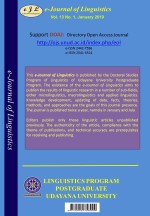Folklore Of Sang Sandiaka Based On The Function Theory, Morphological Theory And Mythological Theory At Depeha Village, Kubu Tambahan District
Abstract
This study aims to find the functions and ideologies of Depeha Village folklore entitled Sang Sandiaka. The focus of the problems to be studied in this study consists of three things; they are: (1) to find out the narrative structure of the folklore of Sang Sandiaka, (2) to find out the functions of the story, and (3) to find out the ideologies in it. The type of this study is qualitative. The theories used in this study are the morphological theory , the function theory and the mythological theory. The data were collected through documentation and interview. Thus the analysis started with a review of Sang Sandiaka's story, then the narrative structure and the function as well as the meaning of the story, and the ideologies contained in it were presented. The results of this study showed that: (1) the story of Sang Sandiaka functions to remind the past, as non-formal education of the community and as the entertainment for the Depeha Village community, and (2) the ideologies which the folklore contain are the ideology of leadership and the ideology of social equality.
Downloads
References
Danandjaya, James. 1994. Foklor Indonesia. Jakarta ; Grafiti
Eco, Umberto. A Theory of Semiotics. Bloomington: Indiana University Press
Eco, Umberto. 1986. Semiotic and the Philosophy of Language. Bloomington : Indiana University Press
Endraswara, Suwardi. 2003. Metodologi Penelitian Sastra. Yogyakarta: Pustaka Widyautama.
Eriyanto, 2001. Analisis Wacana, Pengantar Analisis Teks Media. Yogyakarta : LKIS Universitas Udayana
Geria, I Wayan. 2006. Wacana Samadana Usaba pada Masyarakat Tenganan Pegeringsingan (Desertasi). Denpasar: Universitas Udayana
KBBI, 2016. Kamus Besar Bahasa Indonesia (KBBI). [Online] Available at: http://kbbi.web.id/pusat, [Diakses 21 Februari 2017].
Kutha Ratna, I Nyoman .2004 Teori, Metode, dan Teknik Penelitian Sastra dari Strukturalisme hingga Posstrukturalisme Perspektif Wacana Naratif. Yogyakarta : Pustaka Pelajar.
Kutha Ratna, I Nyoman, 2005. Sastra dan Culutral Studies Representasi Fiksi dan Fakta. Yogyakarta : Pustaka Pelajar.
Sedyawati, Edi. 1996. Kedudukan Tradisi Lisan dalam Ilmu-ilmu Sosialdan Ilmu-ilmu Budaya. Dalam Warta ATL, Jurnal Pengetahuan dan Komunikasi Peneliti dan pemerhati Tradisi Lisan. Edisi II/Maret/1996 Jakarta
Weda Kusuma, I Nyoman. 2002. Penelitian Cerita rakyat Bake di desa Suana Nusa Penida (Buku Austronesia) Denpasar: Bali Medi.

This work is licensed under a Creative Commons Attribution 4.0 International License











